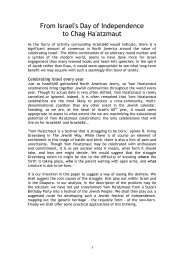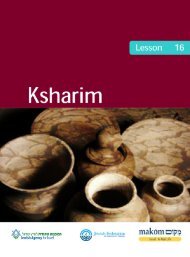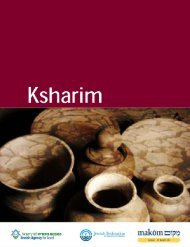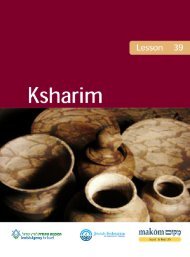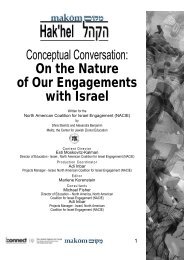Lihiyot Am Chofshi b'Artzenu To be a Free People in ... - Makom Israel
Lihiyot Am Chofshi b'Artzenu To be a Free People in ... - Makom Israel
Lihiyot Am Chofshi b'Artzenu To be a Free People in ... - Makom Israel
You also want an ePaper? Increase the reach of your titles
YUMPU automatically turns print PDFs into web optimized ePapers that Google loves.
9 חג העצמאות – Ha'atzmaut Chag<br />
The form – embody<strong>in</strong>g the festival<br />
Here we <strong>be</strong>g<strong>in</strong> to touch on the relationship <strong>be</strong>tween the essence of the festival, and its<br />
form. Between that which we learn about the festival, and our physical experience of<br />
it.<br />
For example, we looked at the way <strong>in</strong> which Purim came about through an <strong>in</strong>struction<br />
from Mordecai. Now we need to address the connection <strong>be</strong>tween Mordecai's reference to<br />
"feast<strong>in</strong>g and joy", and our experience of fancy-dress, gett<strong>in</strong>g drunk, and mak<strong>in</strong>g a<br />
racket dur<strong>in</strong>g the read<strong>in</strong>g of the Megillah… How do these customs – organically or<br />
rabb<strong>in</strong>ically developed – affect our experience of Purim<br />
The body<br />
In his book How Societies Remem<strong>be</strong>r, Paul Connerton contrasts <strong>in</strong>scriptive practices<br />
(writ<strong>in</strong>g, read<strong>in</strong>g, draw<strong>in</strong>g) with <strong>in</strong>corporative practices (physically embodied actions) –<br />
po<strong>in</strong>t<strong>in</strong>g out the strength of the <strong>in</strong>corporative. The more the event is embodied, the<br />
more likely it will <strong>be</strong> remem<strong>be</strong>red. As we have seen, Purim is a good story, but its<br />
annual embodiment <strong>in</strong> our communities is what makes it memorable.<br />
Work your way through the three chagim we've assessed, answer<strong>in</strong>g the follow<strong>in</strong>g<br />
questions about cloth<strong>in</strong>g, food, venue, movement, and people (we've filled <strong>in</strong> a few<br />
examples here, and have placed larger handout versions of the charts at the end of the<br />
document – Handouts 6 and 7):<br />
What do you put on your<br />
body<br />
What do you put <strong>in</strong> your<br />
body<br />
Where do you place your<br />
body<br />
What do you do with your<br />
body<br />
With whom do you do it<br />
Purim Pesach Sukkot<br />
Costume…<br />
Matzo…<br />
Seder night with<br />
the family…<br />
Sukkah…<br />
Shake lulav,<br />
etrog…<br />
Questions:<br />
Can you see a connection <strong>be</strong>tween the experiences of the body, and the essence of the<br />
festival Does one affect, alter, or symbolize, the other



